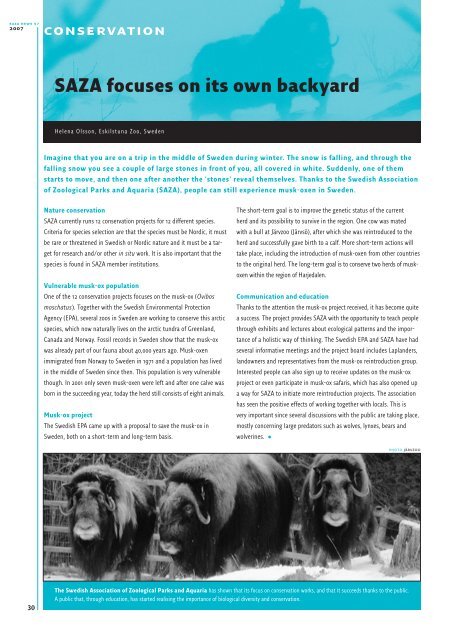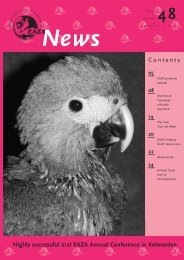EAZA News 57-12 - European Association of Zoos and Aquaria
EAZA News 57-12 - European Association of Zoos and Aquaria
EAZA News 57-12 - European Association of Zoos and Aquaria
You also want an ePaper? Increase the reach of your titles
YUMPU automatically turns print PDFs into web optimized ePapers that Google loves.
eaza news <strong>57</strong><br />
2007<br />
30<br />
conservation<br />
SAZA focuses on its own backyard<br />
Helena Olsson, Eskilstuna Zoo, Sweden<br />
Imagine that you are on a trip in the middle <strong>of</strong> Sweden during winter. The snow is falling, <strong>and</strong> through the<br />
falling snow you see a couple <strong>of</strong> large stones in front <strong>of</strong> you, all covered in white. Suddenly, one <strong>of</strong> them<br />
starts to move, <strong>and</strong> then one after another the ‘stones’ reveal themselves. Thanks to the Swedish <strong>Association</strong><br />
<strong>of</strong> Zoological Parks <strong>and</strong> <strong>Aquaria</strong> (SAZA), people can still experience musk-oxen in Sweden.<br />
Nature conservation<br />
SAZA currently runs <strong>12</strong> conservation projects for <strong>12</strong> different species.<br />
Criteria for species selection are that the species must be Nordic, it must<br />
be rare or threatened in Swedish or Nordic nature <strong>and</strong> it must be a target<br />
for research <strong>and</strong>/or other in situ work. It is also important that the<br />
species is found in SAZA member institutions.<br />
Vulnerable musk-ox population<br />
One <strong>of</strong> the <strong>12</strong> conservation projects focuses on the musk-ox (Ovibos<br />
moschatus). Together with the Swedish Environmental Protection<br />
Agency (EPA), several zoos in Sweden are working to conserve this arctic<br />
species, which now naturally lives on the arctic tundra <strong>of</strong> Greenl<strong>and</strong>,<br />
Canada <strong>and</strong> Norway. Fossil records in Sweden show that the musk-ox<br />
was already part <strong>of</strong> our fauna about 40,000 years ago. Musk-oxen<br />
immigrated from Norway to Sweden in 1971 <strong>and</strong> a population has lived<br />
in the middle <strong>of</strong> Sweden since then. This population is very vulnerable<br />
though. In 2001 only seven musk-oxen were left <strong>and</strong> after one calve was<br />
born in the succeeding year, today the herd still consists <strong>of</strong> eight animals.<br />
Musk-ox project<br />
The Swedish EPA came up with a proposal to save the musk-ox in<br />
Sweden, both on a short-term <strong>and</strong> long-term basis.<br />
The short-term goal is to improve the genetic status <strong>of</strong> the current<br />
herd <strong>and</strong> its possibility to survive in the region. One cow was mated<br />
with a bull at Järvzoo (Järvsö), after which she was reintroduced to the<br />
herd <strong>and</strong> successfully gave birth to a calf. More short-term actions will<br />
take place, including the introduction <strong>of</strong> musk-oxen from other countries<br />
to the original herd. The long-term goal is to conserve two herds <strong>of</strong> muskoxen<br />
within the region <strong>of</strong> Harjedalen.<br />
Communication <strong>and</strong> education<br />
Thanks to the attention the musk-ox project received, it has become quite<br />
a success. The project provides SAZA with the opportunity to teach people<br />
through exhibits <strong>and</strong> lectures about ecological patterns <strong>and</strong> the importance<br />
<strong>of</strong> a holistic way <strong>of</strong> thinking. The Swedish EPA <strong>and</strong> SAZA have had<br />
several informative meetings <strong>and</strong> the project board includes Lapl<strong>and</strong>ers,<br />
l<strong>and</strong>owners <strong>and</strong> representatives from the musk-ox reintroduction group.<br />
Interested people can also sign up to receive updates on the musk-ox<br />
project or even participate in musk-ox safaris, which has also opened up<br />
a way for SAZA to initiate more reintroduction projects. The association<br />
has seen the positive effects <strong>of</strong> working together with locals. This is<br />
very important since several discussions with the public are taking place,<br />
mostly concerning large predators such as wolves, lynxes, bears <strong>and</strong><br />
wolverines. •<br />
photo järvzoo<br />
The Swedish <strong>Association</strong> <strong>of</strong> Zoological Parks <strong>and</strong> <strong>Aquaria</strong> has shown that its focus on conservation works, <strong>and</strong> that it succeeds thanks to the public.<br />
A public that, through education, has started realising the importance <strong>of</strong> biological diversity <strong>and</strong> conservation.

















